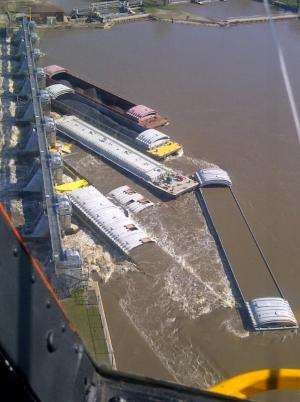Damage assessment of runaway barges at Marseilles lock and dam

It takes a synchronized lock and dam system—operating like a motorized flight of stairs on the Illinois River, using gravity to move the water—to maintain a minimum depth for boat traffic. A disastrous domino effect occurred on April 19, 2013, when heavy rain and runoff, strong winds, and river currents resulted in seven unmoored barges crashing into the dam at Marseilles. University of Illinois soil scientist Ken Olson studied the extensive repercussions of the incident.
"Four of the seven barges partially sank, blocking the southernmost submersible spillway gates that maintain the 9-foot navigation channel," Olson said. "The other three barges blocked the water flow, which backed it up for many miles and flooded adjacent Illinois River bottomlands, including the town of Marseilles."
On the human level, Olson said that approximately 1,500 residents had to be evacuated from the low-lying areas, more than 3 feet of floodwater surrounded 200 buildings, and at least 24 homes were destroyed.
"The greatest agricultural impact was that, because this important waterway transportation system was out of commission, shipments of fertilizers and grains were delayed," Olson said.
The U.S. Army Corps of Engineers (USACE) created a temporary rock dike dam after the accident to permit repairs to the three most severely damaged gates. The temporary dike was able to hold enough water to elevate the navigation pool, but it was not until May 15, four weeks later, that boat traffic was restored.
"The northern stretch of the Illinois River is a main artery for shipping bulk commodities to terminals at the Gulf of Mexico," Olson said. "The interruption affected delivery of shipments of agricultural inputs, such as fertilizer and lime material, and outputs, including grain. The torrential rains that moved through the upper Midwest in April and May of 2013 resulted in the Coast Guard declaring the Illinois River to be unnavigable; any transport required Coast Guard permission."
Olson said that a safety zone was created in order to protect salvage operations from impediment by the vessel traffic above the damaged Marseilles Dam. It extended between the Marseilles Lock and Dam and Seneca, Ill.
"An additional section between Alton, Illinois, and Brendon Road lock at Joliet remained closed for weeks due to high water and excessive river debris," Olson said. "Heavy rains in late May extended the shipping restrictions."
According to Olson, the system of locks and dams on the Illinois River managed by USACE is vulnerable to changing climate and weather extremes. These more frequent and unpredictable conditions can cause shipping accidents, damage to lock and dam systems, streambank erosion, shipping accidents, and local flooding.
"Runaway barges damage Marseilles Lock and Dam during 2013 flood on the Illinois river" was published in the July-August 2014 issue of the Journal of Soil and Water Conservation. Lois Wright Morton co-authored the paper. Olson is a researcher in the Department of Natural Resources and Environmental Sciences in the College of Agricultural, Consumer and Environmental Sciences at the University of Illinois.
More information: The full paper is available at www.jswconline.org/content/69/4/104A.full.pdf
Journal information: Journal of Soil and Water Conservation
Provided by University of Illinois at Urbana-Champaign




















